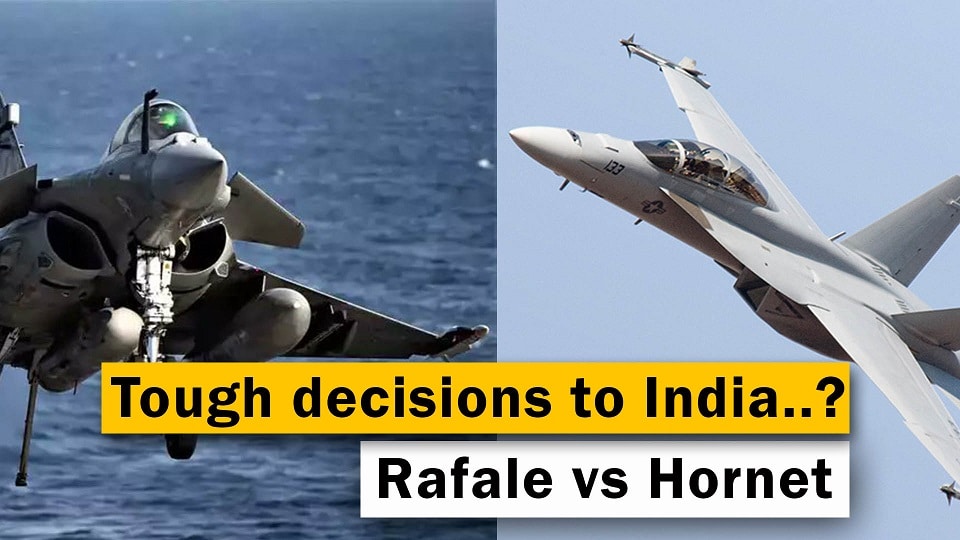Aviation
Why choosing between the Rafale and Hornet F/A 18 aircraft is difficult. Is India still awaiting offers?

The search for suitable aircraft to be deployed on INS Vikrant, India’s indigenous aircraft carrier, began in earnest last year. The naval variant of the French company Dassault’s Rafale fighter jet (the Rafale Marine), as well as Boeing’s F/A-18 Super Hornet, have emerged as the top two contenders over the previous few years. India looked at both in depth.
The main issue is determining the criteria for equipping the Indian defense squad with the appropriate fighter jet. As the F18 aircraft will be extended if India places a new order, or if Boeing closes the F18 production facility, it will continue to maintain the present fleet. Another Rafale 18 is on the current list, however, it is a single-seat marine fighter jet.
Rafale-M and Super Hornet both have their advantages due to similar standardization, but where can India obtain a better deal?
The Indian Navy was delighted by the Rafale-M’s flawless maneuverability. The F/A-18’s potential for Indian aircraft carriers was similarly shown by Boeing in the US in late 2020. Finally, in 2022, at the Indian Naval Station Hansa in Goa, where INS Vikrant’s flight deck was modeled, the two competing multi-role carrier-borne fighters (MRCBF) were requested for operational demonstration tests. The first to enter service was the Rafale-M in February 2022, and Super Hornet in July.
A fighter plane with a similar configuration, the Rafale Marine is designed for the navy. The aircraft is offered in single- and dual-seat configurations, has a delta wing shape, and can resist 11 g. It is 15.27 meters in length and 10.80 meters in width. The GIAT 30M/719B gun on the Rafale is installed on it and has controlled 0.5 or 1-second bursts at 2500 RPM. It has a main missile that can be fired in multi-target fire and forget mode. In addition to the Meteor for battle beyond visual range, the aircraft is also capable of carrying air-to-air MBDA MICA missiles.
In comparison to the Rafale, the F/A-18 has a 20% larger airframe, 41% longer range, and better General Electric F414 engines that produce 35% more thrust. It was created by American aerospace and defense company Boeing. Similar to the Rafale, it travels at a speed of 1.8 Mach. The M61A1 Vulcan revolving canon of the F/A-18 had a maximum rate of fire of 6,000 rounds per minute. It has an AIM-7 Sparrow homing air intercept missile with a semi-active radar. The Super Hornet is equipped with AIM-120 AMRAAM beyond visual range air-to-air missiles.
The government will make the decision in this case. We have accepted both. The Ministry of Defence (MoD) will now make the decision. Both aircraft are in good shape. They have established their worth. However, there will now be additional problems. For instance, the Air Force already has Rafales. The Navy Chief said, “Now there will be a commonality for spare parts and support etc.
The Navy currently operates a Russian MiG 29K for INS Vikrant. But it wants to go for a completely indigenous fighter jet in the future and imported Rafale M or Super Hornet.
The ‘economy’ of the transaction would also be important given that India paid INR 59,000 crores (more than US$8 billion) for 36 Rafale aircraft for the IAF.Even though it would be the maritime version of the Rafale, it is thought that France may offer a better deal on “add-on” aircraft.

Aerospace
India is set to build a central command for the Air Traffic Control system, called ISHAN

India’s air traffic growth has led to increased responsibilities for air traffic control. The Airports Authority of India (AAI) is considering centralizing air traffic control for aircraft, dividing the country into four regions. The goal is to consolidate India’s segmented airspace into a single entity to improve air traffic management (ATM) efficiency, safety, and smoothness.
Recently, the AAI invited expressions of interest to develop a detailed project report for the Indian Single Sky Harmonized Air Traffic Management (ISHAN) initiative in Nagpur. Under this plan, air traffic controllers in Nagpur would handle domestic flights flying above 25,000 feet, eliminating the need for coordination among controllers in different regions.
For domestic regional flights operating above 25,000 feet, control would shift to the central command in Nagpur. This consolidation aims to enhance airline operations, increase flight handling capacity, and reduce congestion and flight times for passengers.
Currently, the AAI provides ATM services over Indian airspace and adjoining oceanic areas, covering over 2.8 million square nautical miles. This airspace is divided into four flight information regions (FIRs) in Delhi, Mumbai, Kolkata, and Chennai, along with a sub-FIR in Guwahati.
FIRs are responsible for providing air traffic services, including weather information, visibility, and search and rescue assistance. The proposed unification under the ISHAN initiative aligns with the projected growth of the aviation industry, which anticipates a doubling of domestic passenger traffic by 2030.
Aviation
Airbus is set to increase the production rate for the A350 as demand surges

Airbus SE is set to boost production of its advanced A350 widebody jet as it capitalizes on rising demand for long-distance travel and wide-body aircraft, amidst the ongoing crisis affecting its competitor Boeing due to issues with the B737 Max.
The surge in orders for Airbus’s A350 aircraft has instilled confidence in the company, prompting them to ramp up production rates. This move is particularly advantageous as Boeing continues to grapple with production quality issues surrounding its 787 and 777x aircraft.
In 2024 alone, Airbus has received 137 orders for the A350, signaling a need to expand manufacturing capabilities to meet customer demands. With 1,277 orders received and 592 aircraft delivered as of April 2024, Airbus is poised to fulfill pending deliveries efficiently.
The European aircraft manufacturer announced plans to increase production of A350 jets to 12 per month by 2028, surpassing earlier projections aiming for 10 per month by 2026. This decision was disclosed alongside the company’s first-quarter figures.
The Asian market is proving lucrative for the A350, with significant orders from airlines like Indigo and Air India, totaling nearly 70 aircraft commitments for the future. Meanwhile, Airbus is progressing with its A220 and A320 programs, aiming for a monthly production rate of 14 and 75 aircraft, respectively, by 2026. Additionally, the long-range A321XLR is anticipated to commence service in the third quarter of the current year.
In contrast, Boeing has been compelled to scale back production due to regulatory pressures aimed at enhancing factory processes. While Airbus anticipates a positive market outlook, Boeing continues to face challenges with FAA certification and quality approvals, resulting in ongoing delays for its 737 Max and 777x models.
Financially, Boeing reported a significant cash burn of $3.9 billion in the first quarter, leaving it with $7.5 billion in cash and short-term securities by the quarter’s end, down from $16 billion at the beginning of the year. Consequently, Boeing’s stock has plummeted by 38% in the year so far, contrasting with Airbus’s 14% gain, marking Boeing’s lowest performance in over a year.
For a full listing including details on customers and regions, as well as historical data for the previous year, go to the download section below.
- March 2024 deliveries: 63 deliveries to 32 customers
- March 2024 gross orders: 137
- 2024 deliveries to date: 142 deliveries to 45 customers
| Single-Aisle | A300/A310 | A330 | A340 | A350 | A380 | TOTAL | |
|---|---|---|---|---|---|---|---|
| Total Orders | 19470 | 816 | 1774 | 377 | 1277 | 251 | 23965 |
| Total Deliveries | 11705 | 816 | 1598 | 377 | 592 | 251 | 15339 |
| Aircraft in Operation | 11007 | 271 | 1482 | 202 | 591 | 234 | 13787 |
Aviation
All passengers killed in plane crash, after pilot let his children to control the plane

When boarding a plane, passengers entrust their safety to the skilled hands of the pilot. However, tragedy struck when one of the flight ended in disaster as all passengers lost their lives in a horrific plane crash.
In 1994, during a flight from Moscow to Hong Kong, tragedy struck as an Aeroflot relief pilot made a fateful decision. In a move that would have devastating consequences, the pilot invited his own children into the cockpit to play with the controls. Little did anyone know, this seemingly innocent gesture would lead to the loss of all 75 lives aboard the aircraft.
It was a seemingly innocent act that led to catastrophic results. The relief pilot, Mr. Kudrinsky, invited his two children, Yana, 12, and Eldar, 15, into the cockpit during the late hours of the night. Little did anyone know, this simple gesture would set off a chain of events that would end in tragedy.
Once in the cockpit, the children were allowed to sit in the captain’s chair and play with the controls, unaware that they should have been disabled as the plane was in autopilot mode.
Eldar, perhaps in a moment of curiosity or innocence, held the control column down for a mere 30 seconds. Yet, in those brief moments, the autopilot disengaged, thrusting the aircraft into manual control.
By the time the pilots regained their seats and attempted to regain control, it was too late. Despite their efforts to pull the plane out of a dive, they overcorrected, causing the flight to climb almost vertically, ultimately stalling it.
Final moment Flight 593 crash
In the final moments, as the pilots struggled to stabilize the aircraft, Flight 593 crashed into the Kuznetsk Alatau Mountain range in southern Russia, completely obliterating the plane and claiming the lives of everyone on board.
Investigations revealed a chilling truth: there was no evidence of technical failure. Instead, the crash was attributed to the unthinkable decision to allow inexperienced hands to manipulate the controls of a commercial aircraft.
The black box recording captured the harrowing sequence of events, providing a grim reminder of the human cost of a lapse in judgment. In just over two minutes, the lives of all on board were tragically short, leaving behind a legacy of sorrow and unanswered questions.




























